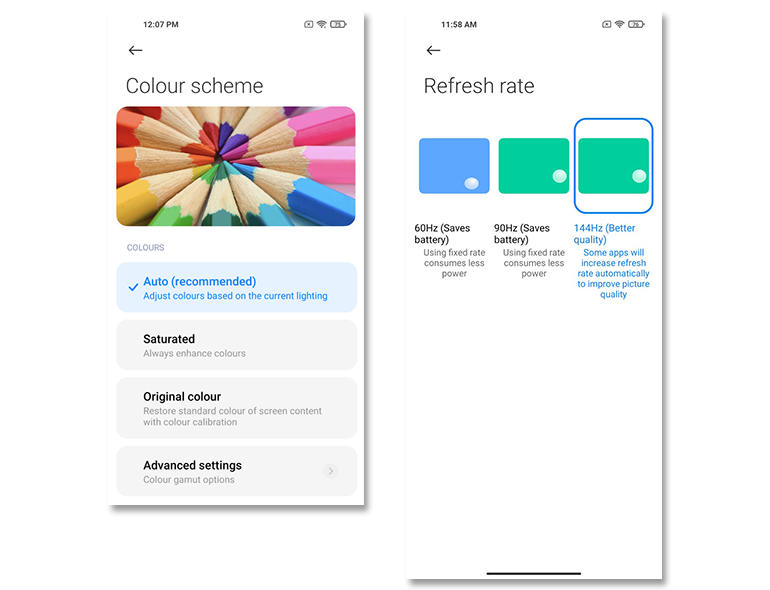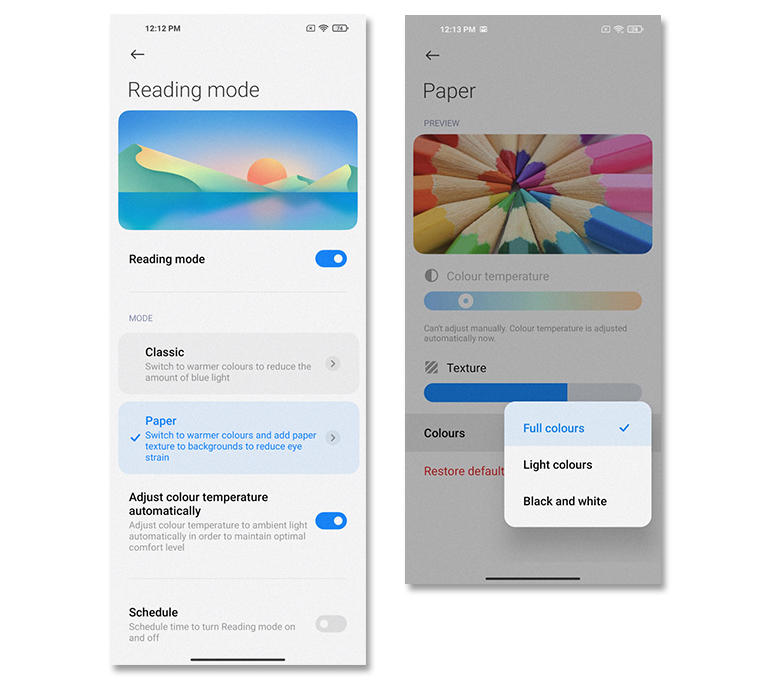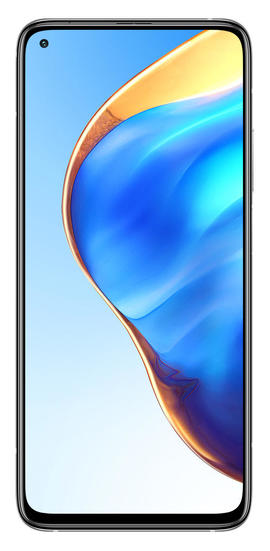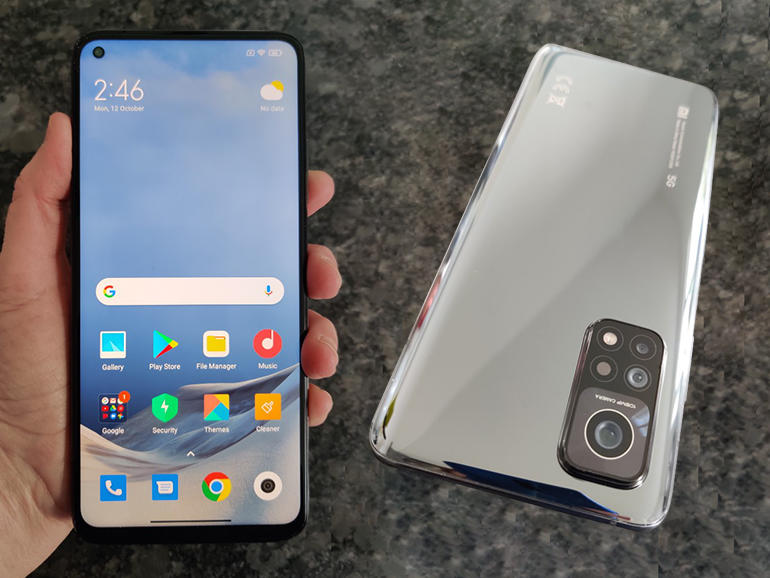The Mi 10T Pro 5G is the latest high-end handset from Xiaomi. It’s an impressive 5G phone with some attractive features, including a 144Hz display, very good performance, a strong reading mode and super-fast charging of its 5,000mAh battery, alongside a competitive price of €599 (UK price TBA).
This is a big phone, with a 6.67-inch display sitting in a body that measures 165.1mm tall and 76.4mm wide. It is 9.33mm thick and weighs 218g. I found it tricky to manage one-handed, because of its size and also because of the shiny, slippery back of my Cosmic Black review unit. This is super-reflective, and seems to absorb rather than reflect light. To its credit the back resisted fingerprints very well. Don’t even think of resting it on your sofa arm, though: in my experience, its favourite pastime in that location was to fall to the floor. There are also Lunar Silver and Aurora Blue variants.
The other really notable point about the chassis is the significantly raised lozenge that houses the rear cameras. This sits over to the left side, which means that the handset bobbles about on a surface when the screen is tapped. This is frustrating: such a severely protruding backplate is better located centrally from the standpoint of desk-based use.
The 6.67-inch Xiaomi Mi 10T Pro 5G runs Android 10 on Qualcomm’s Snapdragon 856 5G chipset with 8GB of RAM and 128GB or 256GB of internal storage (MicroSD expansion not available). There are three rear cameras: 108MP main, 13MP ultra wide-angle and 5MP macro. The IPS LCD screen has a maximum refresh rate of 144Hz.
Images: Sandra Vogel / ZDNet
The Mi 10T Pro 5G uses Gorilla Glass 5 front and back, and the frame is aluminium so there’s plenty of built-in protection. However, there’s no formal IP rating, which might deter some users.
There’s a single speaker at the bottom, with a second one above the screen doing double-duty with its in-call speaker role. Between them they deliver relatively rich sound for a handset, and while the quality is, as usual, lacking in bass tones, there’s minimal distortion at top volume.
The bottom edge also houses the USB-C port and the SIM slot, which caters for two SIMs. The power button on the right edge incorporates a fingerprint reader, which, while not as upmarket as an in-screen sensor, works just fine. The volume rocker sits just above the power button and has a firm, slightly clicky, action. It feels well made, adding to the overall sense of quality in this mid-priced phone.
Top ZDNET Reviews
The left edge is clear of any buttons or connectors, while the top has an IR blaster, which works in conjunction with the preinstalled Mi Remote app to manage devices with IR remote controls. This comes pre-populated with data for a huge range of brands, some of which will be completely useless to a UK audience, but you’ll find the UK high-street brands here too. Adding a remote via Mi Remote is a straightforward process.


Settings for the 6.67-inch IPS LCD screen (650 nits max brightness) include colour scheme and refresh rate.
Images: Sandra Vogel / ZDNet
The 6.67-inch screen has minimal side bezels and a very small upper bezel, but a noticeable bottom bezel of around 4mm. This results in a screen-to-body ratio of 85.1%. There’s a punch-hole in the upper left corner of the screen for the selfie camera that’s about as minimal as possible. The 2,400-by-1,080 pixel screen is IPS LCD rather than AMOLED, so it lacks some vibrancy, but brightness goes to a maximum of 650 nits. You can pick a colour scheme selecting between presets of Auto, Saturated or Original Colour, or make advanced settings for yourself; you can also fiddle with the colour temperature, opting for Default, Warm, Cool or Custom.
There’s also a reading mode, which regular readers of my reviews will know is something I look for on a handset, as I regularly use my phone to read ebooks. In this case there are two options: Classic, which reduces blue light; and Paper, which can itself be set to either present a black-and-white mode or ‘light colours’ — a somewhat washed-out mode which is rather good to use. For fun you can set a screen texture that adds a sort of stippled, paper-like background effect, whose degree you can set with a slider. The options are fine as far as they go, but it doesn’t seem to be possible to have a preset so that a reading mode kicks in when a particular app is launched. Unless I am missing something, this is a bit of an own-goal: OnePlus has offered reading-mode presets on its handsets for several years, for example.


Reading mode options are plentiful, but there are no presets for particular apps.
Images: Sandra Vogel / ZDNet
One of the standout features of the Mi 10T Pro is the screen’s 144Hz refresh rate, which beats all-comers for the moment. You can switch between 144Hz, 90Hz and 60Hz manually in Settings, and the handset employs Smart AdaptiveSync, which will switch the refresh rate automatically depending on what you’re doing. So, for example, gaming can get the full 144Hz experience, but streaming video might not go above 60Hz. I left the higher rate enabled during testing and, not surprisingly, found the screen to be a fast responder, scrolling through content and screens of web pages very smoothly.
The Settings screen is clear that lower refresh rates are less power hungry, but leaving the higher setting on still delivered pretty good battery test results. The 5,000mAh battery kept the handset going for an impressive 22 hours and 2 minutes under the PCMark for Android Work 2.0 battery life test, and when I asked it to play YouTube video full-screen for three hours without a break it lost just 12% from a full charge.
The battery benefits from fast charging too, thanks to 33W wired charging in combination with ‘parallel’ charging’, which is something we are going to see more of. Basically the battery charges in two ‘tracks’ simultaneously, so that it can fill more quickly. Xiaomi quotes an hour for a full charge to 100% which seemed a fair estimate in my experience. There’s no wireless charging.
The Mi 10T Pro runs Android 10, putting it just behind the Android curve — although Android 11 is barely in the wild at the time of writing. Android is augmented with Xiaomi’s MIUI 12 overlay, which adds settings and other tweaks, including a new Control Centre which, if enabled in Settings, will appear when you swipe downwards on the right side of the screen, delivering shortcuts to a range of basic system settings. Swiping downwards on the left edge brings up notifications.
There is 128GB of storage, of which 14.8GB is used out of the box, leaving 109.6GB free. You can’t expand on this with MicroSD.
The Mi 10T Pro runs on Qualcomm’s flagship Snapdragon 865 chipset with 8GB of RAM, and it turned in predictably strong Geekbench 5 CPU benchmarks: 913 (single core) and 3395 (multi core). I last saw multi core scores over 3000 from the £1,099 Sony Xperia 1 II (3362), £569 Realme X50 Pro 5G (3235) and £799 OnePlus 8 Pro (3375) (prices are for comparable RAM/storage configurations).
The main camera at the back has a 108MP sensor and a wide-angle f/1.69 lens. There is also a 13MP ultra-wide angle f/2.4 camera with a 123° field of view and a 5MP f2/4 macro camera with autofocus. The in-screen selfie camera is a 20MP f/2.2 unit. I found the main and macro cameras the most rewarding. You can use up to 30x digital zoom with the main camera, but even at 5x zoom images are somewhat grainy. If you like this phone, don’t need the 144Hz screen refresh, but want better zoom features, check out the similar Mi 10 Pro model, which has 108MP wide-angle, 12MP telephoto (2x optical zoom), 8MP telephoto (10x hybrid zoom) and 20MP ultra wide-angle cameras.


Conclusions
Xiaomi’s Mi 10T Pro 5G is yet another handset that proves you don’t have to pay premium prices to get top-end features. The screen’s 144Hz refresh rate is the headline feature, but there are other plus points, including a top-end chipset, a 108MP main camera, good battery life, a well-made chassis, good audio, and a MIUI 12 overlay that offers plenty of opportunities to tweak and personalise without being too pushy.
There’s stiff competition around this mid-range price point, though, and if you have an interest in Xiaomi handsets you might be advised to see what the upcoming Mi Note 11 brings to the table. The Mi Note 10 I reviewed at the tail end of last year certainly suggests that the next version should be worth waiting for.
RECENT AND RELATED CONTENT
The OnePlus 8T is official with 65W fast charging, 120Hz display
5G almost cheap: The best affordable 5G phones between $400 and $700
Samsung’s new Galaxy A42: This phone brings another 5G mid-range option
10 best smartphones not made in China
The best cheap phones for frugal times: Flagship features on any budget
Read more reviews



